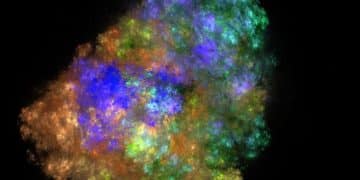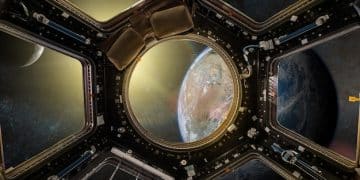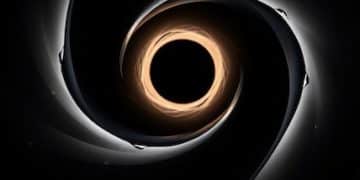Cosmic Microwave Background: Unveiling the Early Universe’s Secrets
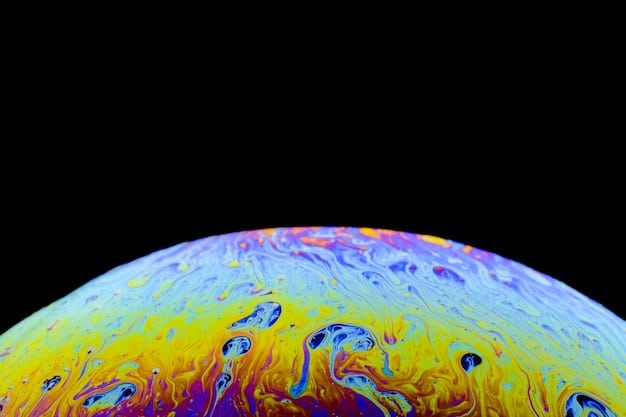
The Cosmic Microwave Background (CMB) is the afterglow of the Big Bang, providing crucial insights into the early universe by revealing its composition, age, and the seeds of cosmic structure formation through precise measurements of its temperature fluctuations.
The Cosmic Microwave Background (CMB), often referred to as the afterglow of the Big Bang, is not just a faint radiation permeating the universe; it’s a treasure trove of information about the cosmos in its infancy, offering clues that help scientists understand the universe’s origins, composition, and evolution.
What is the Cosmic Microwave Background?
The Cosmic Microwave Background is the oldest light in the universe, dating back to about 380,000 years after the Big Bang. During this period, known as the epoch of recombination, the universe cooled enough for electrons and protons to combine and form neutral hydrogen atoms, allowing photons to travel freely through space.
The Discovery of the CMB
The CMB was accidentally discovered in 1964 by Arno Penzias and Robert Wilson, two radio astronomers working at Bell Telephone Laboratories. While trying to eliminate background noise from their radio antenna, they detected a persistent, uniform signal coming from all directions in the sky.
- Uniformity: The CMB is remarkably uniform in temperature, varying only by a few parts in 100,000.
- Isotropy: It appears the same in all directions, indicating that the early universe was highly homogeneous.
- Significance: This discovery provided strong evidence supporting the Big Bang theory and revolutionized the field of cosmology.
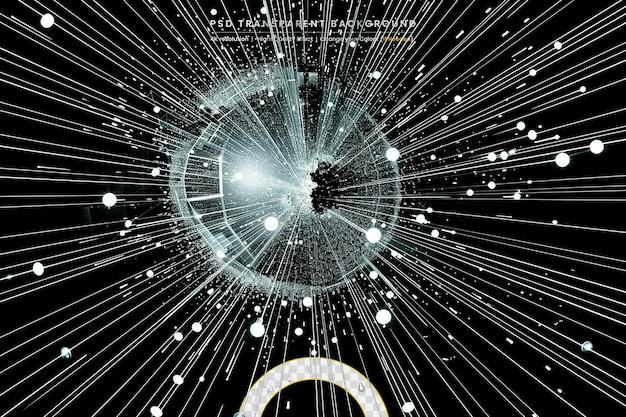
The Cosmic Microwave Background serves as a snapshot of the early universe, providing invaluable data for understanding its fundamental properties and the processes that shaped its evolution.
How is the CMB Measured?
Measuring the CMB requires sophisticated instruments and techniques to detect and analyze the faint microwave radiation. Scientists use ground-based telescopes, high-altitude balloons, and space-based observatories to gather data and create detailed maps of the CMB.
Ground-Based Telescopes
Ground-based telescopes, such as the South Pole Telescope (SPT) and the Atacama Cosmology Telescope (ACT), are located in remote, high-altitude locations to minimize atmospheric interference. These telescopes use sensitive detectors to measure the temperature and polarization of the CMB.
Specialized observatories and equipment are used to isolate the CMB signal from other sources of microwave radiation, such as those emitted by our own galaxy. Signal processing and statistical analysis are crucial for producing high-resolution maps of the CMB.
Measurements of the CMB’s temperature fluctuations offer insights into the distribution of matter and energy in the early universe, revealing information about its composition, density, and geometry.
Space-Based Observatories
Space-based observatories, such as the Cosmic Background Explorer (COBE), the Wilkinson Microwave Anisotropy Probe (WMAP), and the Planck satellite, have played a crucial role in mapping the CMB with unprecedented accuracy and precision. By operating above the Earth’s atmosphere, these observatories avoid atmospheric distortions and can observe the CMB across the entire sky. Analyzing the CMB helps determine key cosmological parameters.
Space-based telescopes are equipped with advanced detectors and instruments to measure the temperature and polarization of the CMB. Precise calibration and data processing techniques are used to remove foreground emissions and systematic errors. The data collected gives scientists a better understanding of inflation and the early universe.
What Does the CMB Tell Us About the Early Universe?
The CMB provides a wealth of information about the early universe, offering clues about its composition, age, and the formation of cosmic structures. By studying the CMB, scientists can test cosmological models and refine our understanding of the universe’s evolution.
Age and Composition of the Universe
The CMB allows scientists to determine the age of the universe with remarkable precision. By analyzing the patterns of temperature fluctuations in the CMB, they can estimate the time elapsed since the Big Bang.
- Age: The current estimate for the age of the universe, based on CMB measurements, is approximately 13.8 billion years.
- Composition: The CMB also provides insights into the composition of the universe, revealing the proportions of ordinary matter, dark matter, and dark energy.
- Dark Matter: The CMB’s power spectrum, which describes the amplitude of temperature fluctuations at different scales, provides strong evidence for the existence of dark matter and dark energy.
Measurements of the CMB have helped constrain cosmological parameters and refine our models of the universe’s evolution, leading to a more accurate and comprehensive understanding of its origins and fate.
Seeds of Cosmic Structure
The CMB reveals subtle temperature fluctuations that correspond to density variations in the early universe. These density variations acted as seeds for the formation of galaxies, galaxy clusters, and other cosmic structures that we observe today. The CMB shows how the universe was just after the big bang.
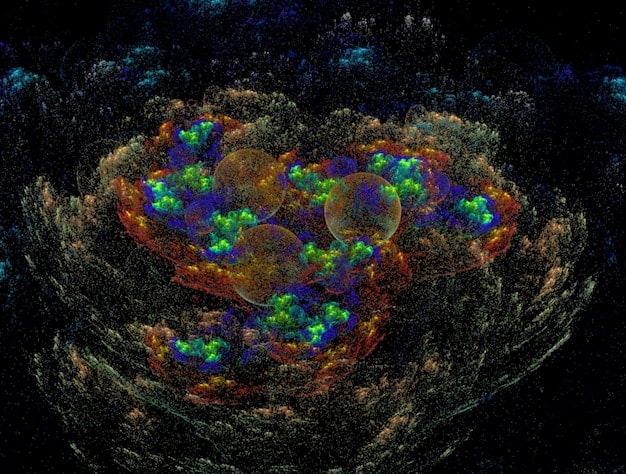
The CMB enables scientists to study the processes that led to the formation of large-scale structures in the universe. By analyzing the spatial distribution and statistical properties of CMB temperature fluctuations, they can understand how gravity amplified these primordial density variations, leading to the formation of galaxies and other cosmic structures.
CMB and Inflation Theory
The Cosmic Microwave Background plays a crucial role in testing and refining the theory of inflation, a leading model for the early universe’s rapid expansion. Inflation predicts specific patterns in the CMB, which scientists can search for and analyze to validate or constrain the theory.
What is Inflation?
Inflation is a period of accelerated expansion in the very early universe, occurring within fractions of a second after the Big Bang. This exponential expansion is believed to have smoothed out the universe, creating a homogeneous and isotropic background upon which cosmic structures could form.
Inflationary models predict that quantum fluctuations during inflation were stretched to macroscopic scales, creating the initial density variations that seeded the formation of galaxies and other cosmic structures. The CMB provides a unique window into this epoch, offering clues about the physics of inflation and the nature of the early universe.
Testing Inflation Through the CMB
The CMB provides several ways to test the predictions of inflation. One crucial test involves searching for specific patterns in the CMB’s polarization, known as B-mode polarization. B-modes are generated by gravitational waves produced during inflation, providing direct evidence for this period of rapid expansion.
The absence of detectable primordial B-modes places constraints on the energy scale of inflation. Analysis of CMB data helps refine our understanding of inflation and the conditions that prevailed in the early universe.
Future Research and the CMB
The Cosmic Microwave Background remains a vibrant area of research, with ongoing and future experiments promising to reveal new insights into the early universe and test fundamental theories of cosmology. These experiments aim to measure the CMB with increasing sensitivity and precision, probing smaller scales and searching for subtle signals that could reveal new physics.
Next-Generation CMB Experiments
Several next-generation CMB experiments are planned for the coming years, including ground-based telescopes, balloon-borne missions, and space-based observatories. These experiments will use advanced detectors and instruments to measure the temperature and polarization of the CMB with unprecedented accuracy.
Future CMB experiments also aim to map the CMB over larger areas of the sky, providing a more complete and detailed picture of the early universe. Observations such as these will help to measure the fundamental physics and cosmological structure.
Searching for New Physics
The CMB provides a unique opportunity to search for new physics beyond the Standard Model of particle physics. For example, scientists can use the CMB to probe the properties of neutrinos, search for evidence of cosmic strings or other topological defects, and test the validity of general relativity on cosmological scales.
Continuing analysis of the Cosmic Microwave Background will provide insights into the early universe’s composition and the formation of large-scale structures, as well as helping to constrain inflationary models.
| Key Point | Brief Description |
|---|---|
| 🔭 CMB Discovery | Accidental finding by Penzias & Wilson in 1964, supporting the Big Bang theory. |
| 🕰️ Universe Age | CMB data estimates the universe’s age at approximately 13.8 billion years. |
| 🌌 Structure Seeds | Temperature fluctuations in the CMB are seeds for cosmic structures. |
| 🔬 Testing Inflation | CMB polarization patterns help test the theory of inflation. |
Frequently Asked Questions
▼
The CMB is the afterglow of the Big Bang, providing crucial data about the early universe’s composition, age, and the seeds of cosmic structure formation.
▼
It was discovered accidentally in 1964 by Arno Penzias and Robert Wilson, who were working on radio astronomy at Bell Telephone Laboratories.
▼
Scientists utilize ground-based telescopes, high-altitude balloons, and space-based observatories to measure the CMB with precision.
▼
Yes, using CMB data, the age of the universe is estimated to be approximately 13.8 billion years.
▼
CMB polarization patterns, especially B-modes, provide direct evidence for the rapid expansion during inflation.
Conclusion
The Cosmic Microwave Background stands as a cornerstone in modern cosmology, offering invaluable insights into the universe’s earliest moments and shaping our understanding of its evolution. As technology advances and new experiments come online, the CMB promises to reveal even more secrets about the cosmos, pushing the boundaries of our knowledge and challenging our current theories.
